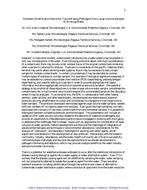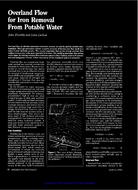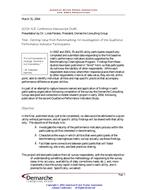Provide PDF Format
AWWA WSC63713
- Portable Ultrafiltration Device for Concentrating Pathogens from Large Volume Samples of Drinking Water
- Conference Proceeding by American Water Works Association, 09/01/2006
- Publisher: AWWA
$12.00$24.00
In a terrorist incident, contaminants introduced into a water system may be present inonly low concentrations in the water. Even following a terrorist attack with high concentrationsof a contaminant, there may be only small residual traces of the original contaminant remainingwhen a sample is collected for analysis. There are no constraints on the specific materials that aterrorist may use to attack drinking water supplies, thus it may be necessary to test a singlesample for multiple contaminants. In certain circumstances it may be desirable to conductmultiple types of analyses on a single sample. For example, if biological agents are suspected, itmay be desirable to conduct polymerase chain reaction (PCR) based testing, antibody/antigenbased testing, and viability testing on a sample in order to provide appropriate risk basedinformation and allow appropriate corrective or preventive actions to be taken. One potentialstrategy to accomplish all these objectives is to take a large volume water sample, concentrate thecontaminants into a much smaller volume and transport this concentrated sample to the laboratorywhere it may be analyzed. To accomplish this, the U.S. Environmental Protection Agency (USEPA), in collaboration with other federalpartners, water utilities, and other stakeholders, has developed and tested several potentialprotocols utilizing ultrafiltration to collect and concentrate microorganisms from large volumewater samples. The protocols developed were tested against large volume water samples, seededwith low numbers of microbes to determine recovery. Even given the high variability normallyassociated with recovery of low level contaminants from environmental samples, it is possible todistinguish between competing protocols and technologies. This paper includes anupdate on USEPA water security activities related to the detection of waterborne pathogens andprovide an opportunity to interested participants to become engaged in working with the Agencyin addressing the challenges that lie ahead. Issues such as: approaches for concentration of largevolumes of water samples, method development activities and the challenges of integration ofadvanced technologies and techniques in environmental laboratories, considerations for theanalysis of "unknowns", and laboratory challenges for working with select agents, are allsignificant considerations in the development of new protocols. Partnerships with the researchcommunity, industry, laboratories, and the public health community are critical to successfullyconfronting these challenges and also provide opportunities to accelerate advancement inpathogen monitoring and detection, which may provide multiple benefits to the water industryand environmental community. Includes 9 references.
Related Products
AWWA C207-94
Steel Pipe Flanges for Waterworks Service - Sized 4 in. Through 144 in. (100mm Through 3600mm)..
$15.00 $30.00
AWWA ACE60041
Getting Value from Benchmarking: An Investigation of the QualServe Performance Indicator Participant..
$12.00 $24.00





